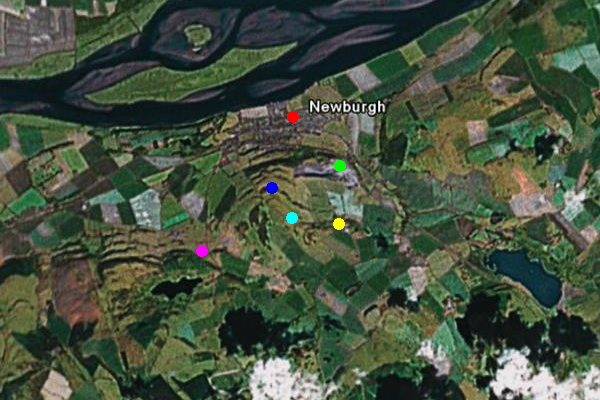

 |
Macduff's Cross is marked with
( |
||
|
Fife is perhaps best known for its mention in Shakespeare's play "Macbeth" wherein Macduff was
the thane of Fife. In Newburgh you will find the remains of Macduff's Cross and learn of its
history.
The Fife town of Newburgh claims inhabitation for over 1000 years and this may well be a conservative guess. Just outside Mugdrum House there is a stone cross (standing 13ft high) of Celtic design. The carvings are considered to be more than 1300 years old. Although it now appears as a pillar, originally it most probably had arms like a real cross. Newburgh (or New Burgh by the Abbey of Lindores as it was then) received its Royal Charter from Alexander III in 1266, with later privileges granted by the Abbot of Lindores in 1457. The town was granted further privileges by both James VI and Charles I. On a hill just a little way south of Newburgh, stands the Macduff Cross. Although badly damaged in 1559 by the Reformers, the cross is still very much a legendary place of sanctuary for those members of the Macduff clan who had been involved in murder. Such Macduff clan members could achieve atonement by performing a series of rituals. Having touched the Macduff stone, they would then wash themselves nine times at nearby Ninewells. The story of Newburgh, however, dates back much further than its abbey. A thousand years earlier, history was already being made on the eastern outskirts of the town, at Carpow. Here, in 208 AD, the Romans built a great fortress which was to be the base for their campaign against the tribes of Angus and Mearns. Unlike England, Scotland never became Romanized, and the fortress at Carpow was eventually demolished by the Romans when they withdrew to the south. Evidence of human settlement around Newburgh extends even further back in time. People built and lived in the hillfort on top of Norman's Law during the last four centuries BC. Today, its remains are accessible by public footpath from the roads north and south of the Law. |

|
Link to the history of
Macduff's Cross near Ormiston Hill
King Macbeth chases Macduff, thane of Fife, past Ormiston Hill in 1057. Macduff kills Macbeth and crowns Malcolm the new king of Scotland. |
||

|
Link to the Bronze Age
Hut-Circle at Ormiston Farm
Recent excavation uncovers artifacts at least 3000 years old. |
||

|
Tragic destruction of the Roman
Hill Fort on Ormiston Hill
Surface mining of stone completely destroys valuable evidence. |

|
Return to ORMISTON PLACES page |
